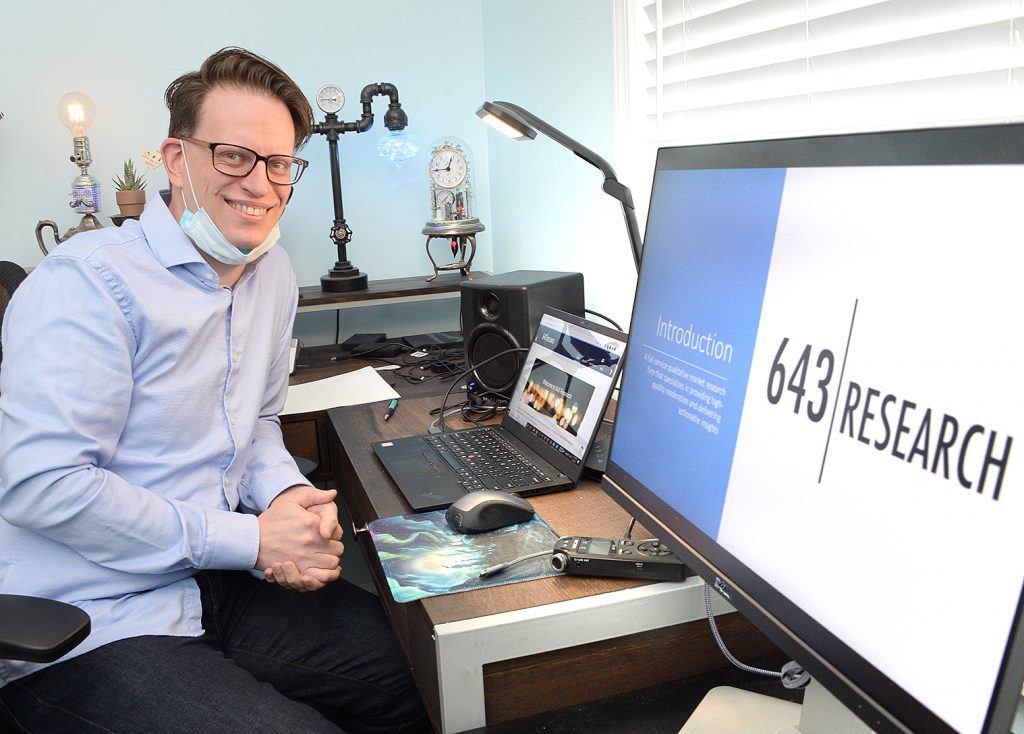
©2021 SaratogaPhotographer.com
By Susan Elise Campbell
When Neal Sandin conducts research, he says he is seeking to interpret “the voice of the consumer” who will inform the next steps of a client company’s marketing.
Sandin’s company, 643 Research, is a qualitative research firm he started in 2014 and moved to Malta in November 2019 when he and his wife relocated from New Jersey.
Sandin said he “fell into” focus group research when the moderator of the firm he worked for double booked and was unavailable for one of the clients, who at the time was en route from out of town to observe his company’s session.
“After about 30 minutes of training I jumped in, conducted the group and was good at it,” said Sandin. “The client continued to use me as a moderator.”
He launched his own firm seven years later.
His clients come from various industries and have a range of goals and challenges. Sandin develops the techniques to reach conclusions and recommendations for advancing a client’s brand and improving customer loyalty. In his toolbox are such qualitative methodologies as ethnography, home visits and focus groups, among others.
Whereas quantitative research relies on enormous sample sizes and mathematics to produce customer service ratings (claims that nine out of 10 dentists recommend that toothpaste), qualitative research is based on the psychology of smaller consumer audiences, he said.
Sandin’s professional interests are steeped in behavioral science, which studies how emotions, the environment and social factors influence decisions. He has an M.A. in international affairs from the New School University and a B.A. in international studies/religion studies at Guilford College.
“There are surprisingly few books about qualitative market research,” said Sandin. “But books about the biology and cultural factors behind behavior give insights into how I approach my work.”
643 Research is brought in either directly by companies with goods or services to sell or by an independent business consultant.
“Sometimes companies and their business consultants are at loggerheads about where the brand should go next,“ he said. “I do the research, give a report with my findings and recommendations and then step back.”
One service Sandin provides clients is to “bridge the gap between quantitative and qualitative results … Qualitative research is about what consumers feel and why they feel that way.”
Sandin pulls in a small number of users and poses questions that were raised by the quantitative research to explain differences of opinion. Generally he will moderate focus groups for consensus or interview individuals if the client needs results to be delineated, he said.
With the pandemic keeping people inside, about 95 percent of his research is conducted remotely, which Sandin describes as “an awkward situation,” especially without the assessment of body language among the interviewees.
“As a moderator over video conferencing, I am like the host of a really weird party,” he said. “I have to encourage everybody to talk, make them comfortable, and create a sense of rapport in order to get a snapshot of what they think at that moment.”
Concept testing comes under the qualitative umbrella, where researchers determine how the public will respond to a new product a company is considering bringing to market.
“A company can spend a lot of time and investment on concepts that just don’t work,” he said. “We want to know why they don’t work. I want the research to determine not just if they’ll buy, but how they will feel about buying.”
Sandin uses the example of a car manufacturer introducing a new exterior design. The car is not in front of the focus group, but the members are shown images. The goal is to get the emotional response, he said, and the moderation process might go something like: How do you feel about this car? How do you want to feel? How do you want other people to feel when they see you in that car?
“We take the insights and feedback and report our conclusions about which elements are working and should be the inspiration for designing that car,” said Sandin. “Our recommendations will further include how to promote that model and what words should be used to describe it.”
“The wording of research questions can influence whether the response is positive or negative,” he said. “Things can be influenced subtly.”
That is why quality control is so important in this field.
“First we make sure we get the right respondents and create a demographic profile of people who have, want, or have rejected the product or service being researched,” said Sandin.
This process starts with a screening survey designed to “weed out the society of professional respondents who do surveys for easy money and sometimes lie. We want only honest, legitimate respondents,” he said.
Next step is to have the right discussion guide, which Sandin said includes a list of questions the client wants answered so that as he writes the guide, he will have those points covered.
“The beauty of qualitative research is that you can change directions quickly. You can say, let’s see what happens now if we ask this question this other way,” he said.
“Interviews at the beginning and at the end of a project can be very different,” Sandin said. “But this means our recommendations will be relevant.”
Sandin said he tries to find new and better methodologies to gain greater insights for his clients.
